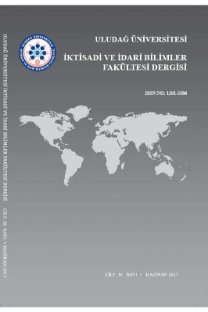Finansal Kırılganlık Endeksi (Türkiye 1989–2011) ve yorumlar
Makalenin amacı, Finansal Kırılganlık Endeksi (FKE) yardımıyla 1989- 2011 arasında Türkiye ekonomisinin temel makro ekonomik göstergelerindeki değişim ve bu değişimin sonuçlarının analiz edilmesidir. Bu bağlamda Türkiye ekonomisi için 8 makro ekonomik temel değişken seçilerek, bir FKE türetilmiştir. Bu sekiz değişken şunlardır: (1) Cari İşlemler Dengesi/GSMH; (2) Reel Kur Endeksi, (3) İthalat/İhracat (4) Kısa Vadeli dış borç/ TCMB döviz Rezervleri; (5) Konsolide Bütçe Dengesi/GSMH; (6) İMKB 100 endeksinin yıllık artış oranı(7) Kısa-vadeli Dış Borç/Orta ve Uzun-vadeli Dış Borç; (8)Kamu Net Borç Stoku/GSMH. Finansal kırılganlığın arttığını gösteren “eşik değer” 0.40 olarak bulunmuş ve bu eşik değerin hem 1994 hem de 2001 krizlerini önceden tahmin etme yetisi olduğu gözlenmiştir. Endeks değeri; 1992 ve 1999 yıl-sonu itibariyle düşükken (sırasıyla - 0,06 ve 0,25), 1993 yıl-sonunda 0.98; 2000’de ise 0.90 değerine ulaşarak, ekonomide kırılganlığın artığına dair çok güçlü sinyaller üretmiştir. Buna karşın endeks değeri, finansal kırılganlığın artığını gösteren eşik değere 2001 krizinden sonra hiç ulaşamamış; 2008-2009 krizini öngören bir sinyal üretmemiştir. Ama bu da, 2008-2009 krizinin yurtiçi değil yurt-dışı kaynaklı olduğu göz önüne alınırsa, olması gerektiği gibidir.
A Financial Vulnerability Index (Turkey 1989-2011) and comments
The main purpose of this article is to take a snap-shot of the changes that occurred in the key macro variables of the Turkish economy in the past two decades and to comment on the results. ln this context a Financial Vulnerability Index (FVI) was constructed using the following eight selected fundamental variables for the 1989-2011 period: (1) Ratio of the the Current Account Balance to GDP, (2) The Reel Exchange-Index, (3)Imports/Exports Ratio, (4) Ratio of Short Term Foreign Debt to Central Bank Forex Reserves, (5) Budget Deficits/GNP Ratio, (6) The annual Rate of Increase in the IMKB-100 Index, (7) Ratio of Short-Term to Medium + Long-Term Foreign Debt and (8) Public Debt Stock /GNP Ratio. This FVI, the threshold-value of which is 0.40, was successful in predicting both the 1994 and 2001 currency crises for it has produced strong signals in the years immediately preceding the two “home-made” crises: While low as of the year end of 1992 and 1999 (-0.06 and 0.025 respectively), the index rose precipitously to 0.98 and 0.90 (respectively) as of years’ end of 1992 and 2000. Between 2002-2011, this index oscillated but never crossed the threshold value and thus did not produce any predictive signals preceding the 2008-2009 crises. But considering the fact that the said crises was “imported” and not “home-made”, this is neither surprising nor can be construed as a failure to predict
___
Akkemik, Ali (2011), “Japonya (1991) ve ABD (2007-2009) Finansal Krizlerinin Politik İktisat Perspektifinden Bir Değerlendirilmesi”, Doğuş Üniversitesi Dergisi, 12(2):171-186.Boratav, Korkut (2001), “Finansal Kriz IMF’nin Eseridir”, http://www.bilkent.edu.tr/~yeldanbs/Yazilar_Uye/Boratav_IMF.html(05- 10-2006).
Bustelo, Pablo (2000) “Novelties of Financial Crises in the 1990s and the Search for new Indicators”, Emerging Markets Review, Vol: 1, No: 3:229–251.
Çakmak, Umut (2007), “Kriz Modelleri Çerçevesinde Türkiye 2001 Finansal Krizinin Değerlendirilmesi”, Gazi Üniversitesi iktisadi ve İdari Bilimler Fakültesi Dergisi 9/I: 81-101
Çakman, Kemal, U. Çakmak (2007), “Cari İşlemler Açığı, Net Sermaye Hareketi, Kur Değişim Hızı ve Reel Kur Endeksi: Bağlamındaki İkilemlerin Bir Analizi”, Finans Politik ve Ekonomik Yorumlar, Yıl 44, Sayı 510.
Dornbusch, Rudriger (2001), “A Primer on Emerging Market Crises”, NBER Working Paper, No:8326:1-12.
Flood, Robert ve P. M. Garber (1984), “Collapsing Exchange-Rate Regimes: Some Linear Examples”,Journal of International Economics, Vol:17: 1-13.
Frankel, Jeffrey ve A. Rose (1996) “Currency Crashes in Emerging Markets; An Empirical Treatment”, Journal of International Economics, Vol:41, No:3– 4:351–366.
IMF, (1998) “Financial Crises: Characteristics and Indicators of Vulnerability” World Economic and Financial Surveys World Economic Outlook, Bölüm IV:74-97.
Kaminsky, Graciela, S. Lizondo ve C. Reinhart (1998) “Leading Indicators of Currency Crises” IMF Staff Paper, Vol:45, No:1:1-48.
Krugman, Paul (1979), “A Model of Balance-of-Payments Crises”, Journal of Money, Credit and Banking, Vol:11, No:3: 310-325.
Milesi-Ferretti, G.M. ve A. Razin (1996), “Current-Account Sustainability”, Princeton Studies in International Finance, No:81:1-78.
Milesi-Ferretti, G.M. ve A. Razin (1998) “Current Account Reversals and Currency Crises”, NBER Konferans Metni, Cambridge, Şubat 6-7:1-50.
Minsky, Hyman P. (1992), “The Financial Instability Hypothesis” The Jerome Levy Economics Institute of Bard College Working Paper, No:74:1-10.
Obstfeld, Maurice (1996), “Models of Currency Crises with Self-Fulfilling Features”, European Economic Review, Vol:40: 1037-1047.
Oktar, Suat ve L. Dalyancı (2010), “Finansal Kriz Teorileri ve Türkiye Ekonomisinde 1990 Sonrası Finansal Krizler”, Marmara Üniversitesi İ.İ.B.F. Dergisi, Cilt:XXIX, Sayı:II:1-22.
Reinhart, Carmen, Goldstein M. ve Kaminsky G.(2000) “Assessing Financial Vulnerability: An Early Warning System for Emerging Markets”, University of Maryland, College Park, Department of Economics MPRA Paper No:13629:1-56.
Roubini, Nouriel ve P. Wachtel (1998), “Current Account Sustainability in Transition Economies.”, NBER Working Paper, No: 6468: 1-63.
Salant, Stephen ve D. Henderson (1978), “Market Anticipation of Government Policy and the Price of Gold”, Journal of Political Economy, Vol:86: 627- 648.
Uygur, Ercan (2001), “Krizden Krize Türkiye: 2000 Kasım ve 2001 Şubat Krizleri”, Türkiye Ekonomi Kurumu Tartışma Metni, 1:1-36.
- ISSN: 1301-3386
- Yayın Aralığı: Yılda 2 Sayı
- Başlangıç: 2018
Sayıdaki Diğer Makaleler
Türkiye'de Bütünleşik Kıyı Yönetiminin aktörleri, rolleri ve sorumlulukları
İBRAHİM GÜRAY YONTAR, FERİŞTAH YILMAZ
Trade effects of Turkey’s antidumping duties
Finansal Kırılganlık Endeksi (Türkiye 1989–2011) ve yorumlar
Marka kaçınması: Beyaz eşya markalarına yönelik kalitatif bir uygulama
A virtual organization model for international LCL transportation
Ceren ALTUNTAŞ, OSMAN AVŞAR KURGUN
AB Ülkeleri’nde bütünleşik Entropi Ağırlık-Topsis yöntemiyle AR-GE performansının ölçülmesi
Yaşam kalitesi ekseninde şekillenen alternatif Bir Kentsel yaşam modeli: Yavaş Kentleşme hareketi
Diyarbakır’da faaliyet gösteren KOBİ’lerin finansman sorunu çözümünde Kredi Garanti Fonu
